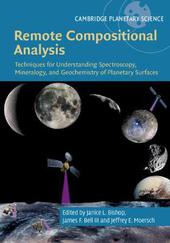
|
Remote Compositional Analysis: Techniques for Understanding Spectroscopy, Mineralogy, and Geochemistry of Planetary Surfaces
Hardback
Main Details
| Title |
Remote Compositional Analysis: Techniques for Understanding Spectroscopy, Mineralogy, and Geochemistry of Planetary Surfaces
|
| Authors and Contributors |
Edited by Janice L. Bishop
|
|
Edited by James F. Bell III
|
|
Edited by Jeffrey E. Moersch
|
| Series | Cambridge Planetary Science |
|---|
| Physical Properties |
| Format:Hardback | | Pages:652 | | Dimensions(mm): Height 257,Width 177 |
|
| Category/Genre | Solar system
Rocks, minerals and fossils |
|---|
| ISBN/Barcode |
9781107186200
|
| Classifications | Dewey:523.40287 |
|---|
| Audience | | Professional & Vocational | |
|---|
| Illustrations |
Worked examples or Exercises; 147 Plates, color; 14 Halftones, black and white; 18 Line drawings, black and white
|
|
Publishing Details |
| Publisher |
Cambridge University Press
|
| Imprint |
Cambridge University Press
|
| Publication Date |
28 November 2019 |
| Publication Country |
United Kingdom
|
Description
How do planetary scientists analyze and interpret data from laboratory, telescopic, and spacecraft observations of planetary surfaces? What elements, minerals, and volatiles are found on the surfaces of our Solar System's planets, moons, asteroids, and comets? This comprehensive volume answers these topical questions by providing an overview of the theory and techniques of remote compositional analysis of planetary surfaces. Bringing together eminent researchers in Solar System exploration, it describes state-of-the-art results from spectroscopic, mineralogical, and geochemical techniques used to analyze the surfaces of planets, moons, and small bodies. The book introduces the methodology and theoretical background of each technique, and presents the latest advances in space exploration, telescopic and laboratory instrumentation, and major new work in theoretical studies. This engaging volume provides a comprehensive reference on planetary surface composition and mineralogy for advanced students, researchers, and professional scientists.
Author Biography
Janice L. Bishop is a senior research scientist at the SETI Institute, where she is Chair of Astrobiology and on the Science Council. She investigates Mars surface composition, mineral spectroscopy, and volcanic alteration, and has worked with data from many martian missions, including MRO/CRISM for which she is a Co-I. She has served as Editor for Icarus and special issues in American Mineralogist and Clay Minerals. She has received awards from the Clay Minerals Society, the Humboldt Foundation and the Helmholtz Foundation, and is a Geological Society of America (GSA) Fellow. Jim Bell is a professor at Arizona State University, where he specializes in astronomy and planetary science. He studies the geology, geochemistry and mineralogy of Solar System objects using telescopes and spacecraft. He received the Carl Sagan Medal from the American Astronomical Society for excellence in public communication in the planetary sciences, and asteroid 8146 Jimbell was named after him by the IAU. He edited The Martian Surface: Composition, Mineralogy and Physical Properties (Cambridge, 2008) and co-edited Asteroid Rendezvous (Cambridge, 2002). Jeffrey E. Moersch is Professor of Earth and Planetary Sciences at the University of Tennessee. His research focuses on the geology of planetary surfaces, remote sensing, terrestrial analog field work, and planetary instrument development. He has extensive spacecraft mission experience, including work as a member of the science teams of the Mars Exploration Rover mission, the Mars Odyssey mission, and the Mars Science Laboratory mission. He has conducted astrobiology-related research in many terrestrial analog field sites, including Death Valley and the Mojave Desert, the Atacama Desert, the Andes and the Arctic. From 2010 to 2015 he was the Mars Editor for Icarus.
Reviews'... provides a thoroughly updated entry point to the field, covering the techniques used on missions from Mercury to Pluto and almost everywhere in between ... Researchers will appreciate the copious end-of-chapter references (chapter 3 alone provides 132 citations). Though the density of information may be intimidating to novices, libraries supporting graduate astronomy programs should certainly acquire this book.' S. G. Decker, Choice
|